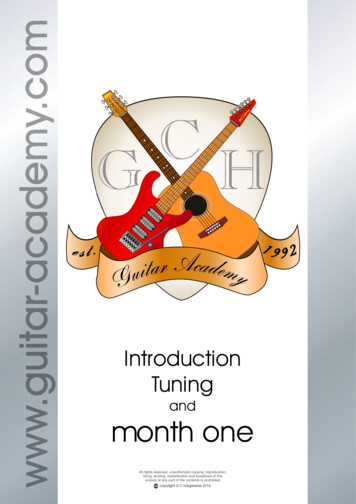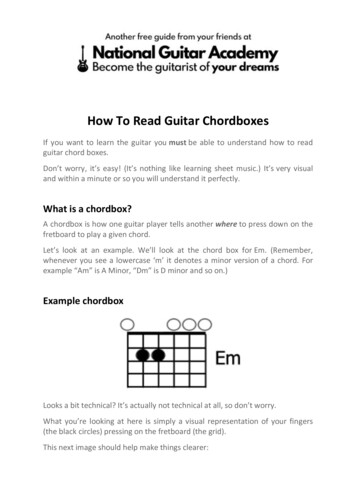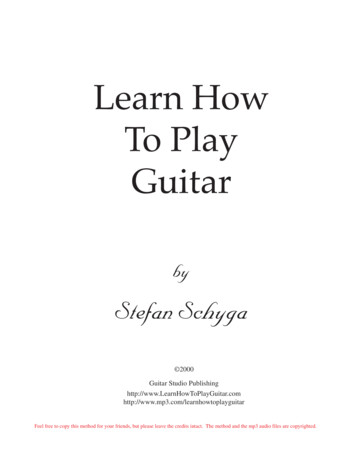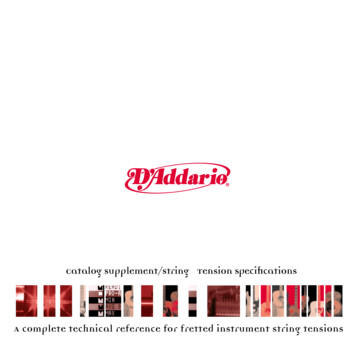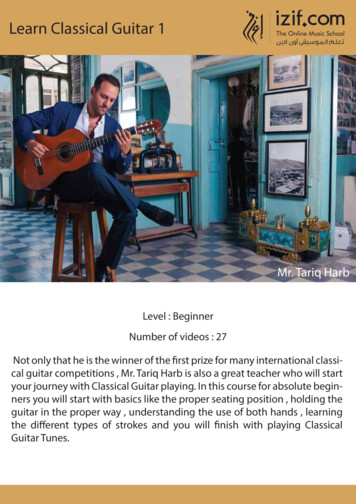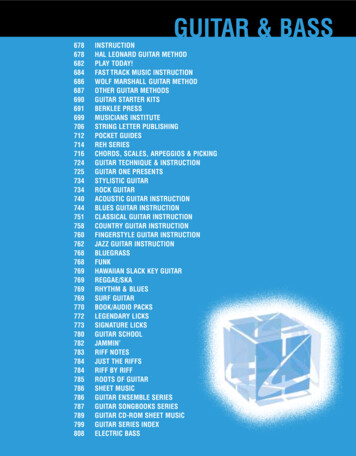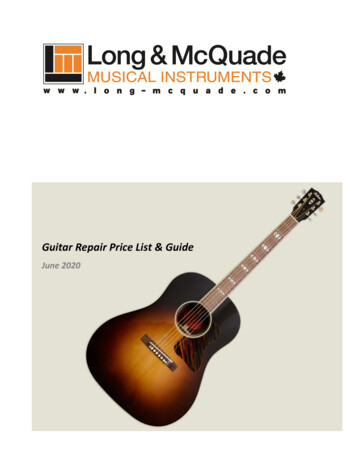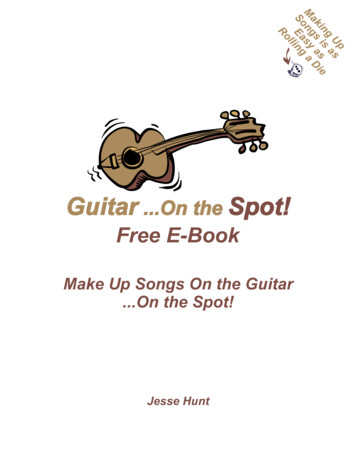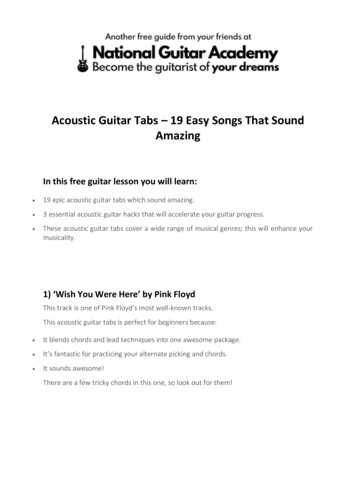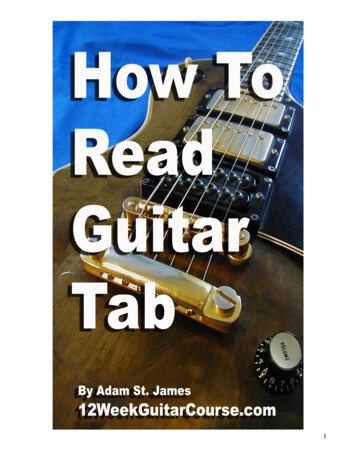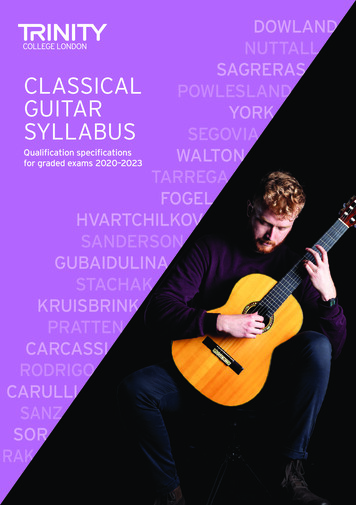
Transcription
KSYLLABUSSEGOVIAQualification specificationsWALTONfor graded exams ISANZSORRAK
WHAT’S CHANGED? Repertoire lists refreshed at all levels, encompassing a wide range of musical styles Duets now available up to Grade 5 New graded exam books, featuring a wide range of pieces and duets Pieces only divided into groups at Grades 6–8 — at other grades, pieces can be chosen froma single list At Grades 6–8, at least one piece must now be chosen from each group New Acoustic Guitar exams incorporating elements of the Plectrum Guitar exams availablefrom 2020. More information available in our Acoustic Guitar Syllabus 2020–2023 An information and regulations section is no longer included in this syllabus — this informationcan be found at trinitycollege.com/music-regulationsKEEP UP TO DATEPlease check trinitycollege.com/classical-guitar to make sure you are using the latest version ofthe syllabus and for the latest information about our Classical Guitar exams.OVERLAP ARRANGEMENTSThis syllabus is valid from 1 January 2020. The 2016–2019 syllabus will remain valid until31 December 2020, giving a one year overlap. During this time, candidates may presentpieces and technical work from the 2016–2019 or the 2020–2023 syllabus, but not both.Candidates should indicate which syllabus they are presenting on the appointment formhanded to the examiner at the start of the exam.
CLASSICALGUITARSYLLABUSQualification specificationsfor graded exams 2020–2023Trinity College Londontrinitycollege.comCharity number England & Wales: 1014792Charity number Scotland: SC049143Patron: HRH The Duke of Kent KGChief Executive: Sarah KempCopyright 2019 Trinity College LondonPublished by Trinity College LondonOnline edition, October 2019
HeadingContents3 /Welcome4 /Introduction to Trinity’s graded music exams9 /Learning outcomes and assessment criteria11 /About the exam14 /Exam guidance: Pieces16 /Exam guidance: Technical work17 /Exam guidance: Supporting tests28 /Exam guidance: Marking36 /Initial to Grade 537 /Initial40 /Grade 143 /Grade 246 /Grade 349 /Grade 452 /Grade 555 /Grades 6–856 /Grade 660 /Grade 764 /Grade 868 /Policies70 /Publishers and UK specialist supplier72 /Trinity publications73 /Classical Guitar resourcesTrinity accepts entries for its exams on the condition that candidates conform to therequirements of the appropriate syllabus. Any amendments to the requirements willbe published and advertised via our website and in subsequent imprints.2
WelcomeWelcomeWelcome to Trinity College London’s Classical Guitar syllabus containing details of graded examsfrom Initial to Grade 8. It offers the choice and flexibility to allow classical guitarists to playto their strengths, offering wide-ranging repertoire choices as well as exercises designed toprogressively develop the technique classical guitarists really need from the early grades rightthe way through to Grade 8.Styles and duetsWelcomeEncompassing a range of inspiring repertoire from the Renaissance to the present day, thesyllabus includes pieces published for the first time and more music by female composers.The duets option is now available up to Grade 5.BooksNew graded books for Initial to Grade 8 feature a wide range of repertoire, while expandedalternative piece lists include options from Trinity’s Raise the Bar and Performance Edition seriesof publications.TechniquesTechnical work includes specially composed exercises for each grade, covering the techniquerequired specifically by guitarists, ensuring that all learners put scales and arpeggios into theperformance context.Benefit from industry expertiseThe syllabus and supporting books have been created in consultation with leading classicalguitar specialists. You can access videos and articles produced with professionals to supportteaching and learning at trinitycollege.com/guitar-resources. Join us online and on social mediato find out when new resources are available.We hope you enjoy exploring the music on offer in this syllabus and we wish you every successin the exams and your wider music-making.ABOUT TRINITY COLLEGE LONDONTrinity College London is a leading international exam board and independent educationcharity that has been providing assessments around the world since 1877. We specialise in theassessment of communicative and performance skills covering music, drama, combined arts andEnglish language. With over 850,000 candidates a year in more than 60 countries worldwide,Trinity qualifications are specifically designed to help students progress. Our aim is to inspireteachers and learners through the creation of assessments that are enjoyable to prepare for,rewarding to teach and that develop the skills needed in real life.At the heart of Trinity’s work is the belief that effective communicative and performance skillsare life enhancing, know no boundaries and should be within reach of us all. We exist to promoteand foster the best possible communicative and performance skills through assessment, contentand training that is innovative, personal and authentic.3
Introduction to Trinity’s graded music examsIntroduction to Trinity’sgraded music examsOBJECTIVE OF THE QUALIFICATIONSASSESSMENT AND MARKINGTrinity’s graded music exams provide astructured yet flexible framework for progress,which enables learners to demonstratetheir own musical personality and promotesenjoyment in music performance.Trinity’s graded music exams are assessed byexternal examiners trained and moderatedby Trinity. Examiners provide marks andcomments for each component of the examusing the assessment criteria on pages 30–35.The exams assess performance, technicalability and responses to set musical teststhrough face-to-face practical assessment.They offer learners of any age the opportunityto measure their development as performersagainst a series of internationally understoodbenchmarks, taking them from beginnerlevel to the point where they can progressto higher education in music, or enter forTrinity’s performance diplomas.The exams are marked out of 100. Candidates’results correspond to different attainmentlevels as follows:MarkAttainment level87–100DISTINCTION75–86MERIT60–74PASSWHO THE QUALIFICATIONS ARE FOR45–59BELOW PASS 1Trinity’s graded music exams are open to alllearners, with no age restrictions or otherlimitations. There is no requirement to havepassed lower grades, theory exams or otherqualifications, although the grades representa system of progressive mastery and theoutcomes for each level assume confidencein the requirements of previous grades.0–44BELOW PASS 2Repertoire selection and other exam contentis designed to appeal to learners of all agesand backgrounds, reflecting the diversityof candidates.Trinity is committed to making its examsaccessible to all, and each candidate istreated individually when considering howassessments can be adapted for thosewith special needs. Find out more attrinitycollege.com/music-csn4See pages 28–35 for further information abouthow the exams are marked.
Introduction to Trinity’s graded music examsDURATION OF STUDY (TOTAL QUALIFICATION TIME)All regulated qualifications are assigned a total qualification time. This should be used as guidanceonly. Total qualification time is an estimate of the average time a candidate spends with a teacher(guided learning hours) added to the average time spent learning independently. It is recognisedthat the amount of time needed to commit to a qualification will be dependent on each individual’slevel of experience.Guided learning hours(GLH)Independent learning hours Total qualification time(ILH)(TQT) (hours)83240Grade 1124860Grade 2187290Grade 318102120Grade 424126150Grade 524156180Grade 636184220Grade 748222270Grade 854266320RECOGNITION AND UCAS POINTSTrinity College London is an internationalexam board regulated by Ofqual (Officeof Qualifications and ExaminationsRegulation) in England, CCEA Regulationin Northern Ireland and by QualificationsWales. Various arrangements are inplace with governmental educationauthorities worldwide.In the UK, Grades 6–8 are eligible for UCAS(Universities and Colleges Admissions Service)points for those applying to colleges anduniversities, as follows:Grade 6IntroductionInitialWHERE THE QUALIFICATIONSCOULD LEADWhile for some learners graded music examsrepresent a personal goal or objective,they can also be used as a progressionroute towards: D iplomas in performing and teachingoffered by Trinity or by other awardingorganisations Music courses at conservatories anduniversities, for which Grade 8 is oftenspecified as an entry requirement Employment opportunities in musicand the creative artsUCAS POINTSPASS 8 MERIT 10 DISTINCTION 12Grade 7UCAS POINTSPASS 12 MERIT 14 DISTINCTION 16Grade 8UCAS POINTSPASS 18 MERIT 24 DISTINCTION 305
Introduction to Trinity’s graded music examsHOW TO ENTER FOR AN EXAMExams can be taken at Trinity’s publicexam centres, which are availablethroughout the world. Details are availableat trinitycollege.com/worldwide, andcandidates should contact their localTrinity representative for more information.Alternatively, in the UK, schools and privateteachers with sufficient candidates may applyfor an exam visit. Details are available attrinitycollege.com/exam-visitTRINITY QUALIFICATIONS THATCOMPLEMENT THE CLASSICAL GUITARQUALIFICATIONSTrinity’s music qualifications offer flexibleprogression routes from beginner to advancedlevels in a range of musical styles. All aredesigned to help candidates develop asmusicians according to their individualneeds as learners.Graded music exams assess a broad range ofmusicianship skills, including performance, whilecertificate exams focus entirely on performance,including separate marks for presentation skills.Find more information about certificate examsat trinitycollege.com/music-certificatesTrinity’s graded Rock & Pop exams areavailable for bass, drums, guitar, keyboardsand vocals. Find out more at trinityrock.comCandidates can enter any combination ofgraded or certificate exams, and do not needto pass any particular level in order to proceedto a higher level.Theory exams are available from Grade 1to support learners to develop theirunderstanding of the technical languageof music. However, no theory qualificationsor other prerequisites are required to entergraded or certificate exams at any level.Find out more at trinitycollege.com/theory6OTHER QUALIFICATIONS OFFEREDBY TRINITYAfter Grade 8 or the Advanced Certificateclassical music exams, candidates canprogress to diplomas at Associate (ATCL),Licentiate (LTCL) and Fellowship (FTCL) levels.These assess higher skills in performance,teaching and theory. Find out more attrinitycollege.com/music-diplomasAdults who work as music educators may alsowish to consider Trinity’s Level 4 Certificatefor Music Educators (Trinity CME). Find outmore at trinitycollege.com/CMEWe also offer: Graded, certificate and diplomaqualifications in drama subjects English language qualifications Teaching English qualifications Arts Award (only available in certaincountries)Specifications for all these qualificationscan be downloaded from trinitycollege.com
Introduction to Trinity’s graded music examsREGULATED LEVELS OF TRINITY’S MUSIC QUALIFICATIONSEQF**LevelClassical& Jazz77FTCL66LTCLLMusTCLATCLAMusTCL4321EntryLevel 354Rock& PopTheory& dationIntroductionRQF*LevelCertificate for Music Educators(Trinity CME)Grade 8Grade 8Grade 8Grade 7Grade 7Grade 7Grade 6Grade 6Grade 6Grade 5Grade 5Grade 5Grade 4Grade 4Grade 4Grade 3Grade 3Grade 3Grade 2Grade 2Grade 2Grade 1Grade 1Grade 1InitialInitial321* Regulated Qualifications Framework** European Qualifications Framework† Not RQF or EQF regulated7
Introduction to Trinity’s graded music examsREGULATED TITLES AND QUALIFICATION NUMBERSFOR GRADED MUSIC EXAMSRegulated titleQualificationnumberInitialTCL Entry Level Award in Graded Examination in Music Performance(Entry 3) (Initial)601/0812/5Grade 1TCL Level 1 Award in Graded Examination in Music Performance(Grade 1)501/2042/6Grade 2TCL Level 1 Award in Graded Examination in Music Performance(Grade 2)501/2041/4Grade 3TCL Level 1 Award in Graded Examination in Music Performance(Grade 3)501/2043/8Grade 4TCL Level 2 Certificate in Graded Examination in Music Performance(Grade 4)501/2044/XGrade 5TCL Level 2 Certificate in Graded Examination in Music Performance(Grade 5)501/2045/1Grade 6TCL Level 3 Certificate in Graded Examination in Music Performance(Grade 6)501/2097/9Grade 7TCL Level 3 Certificate in Graded Examination in Music Performance(Grade 7)501/2098/0Grade 8TCL Level 3 Certificate in Graded Examination in Music Performance(Grade 8)501/2099/28
Learning outcomesand assessment criteriaINITIAL–GRADE 3(Initial RQF Entry Level 3, Grades 1–3 RQF Level 1)LEARNING OUTCOMESASSESSMENT CRITERIAThe learner will:The learner can:1.Perform music in avariety of styles setfor the grade1.1 Apply skills, knowledge and understanding to presentperformances that demonstrate careful preparation, musicalawareness and the beginning of thoughtful interpretation1.2 Perform with general security of pitch and rhythm, and withattention given to dynamics and articulation1.3 Maintain a reasonable sense of continuity in performanceand convey the mood of music in a variety of styles2.Demonstrate technicalability on an instrumentthrough responding toset technical demands3.Respond to setmusicianship tests2.1 Demonstrate familiarity with the fundamentals ofinstrumental command2.2 Demonstrate technical control and facility within set tasks3.1 Recognise and respond to simple elements of music in apractical context3.2 Demonstrate basic aural and musical awareness9Learning outcomes and assessment criteriaLearning outcomes and assessment criteria
Learning outcomes and assessment criteriaGRADES 4–5(RQF Level 2)LEARNING OUTCOMESASSESSMENT CRITERIAThe learner will:The learner can:1.Perform music in avariety of styles setfor the grade1.1 Support their intentions in musical performance1.2 Demonstrate an understanding of music that allowsa degree of personal interpretation in performance1.3 Perform with general accuracy, technical fluency andmusical awareness to convey musical character in avariety of styles2.Demonstrate technicalability on an instrumentthrough responding toset technical demands3.Respond to setmusicianship tests2.1 Demonstrate a developing instrumental command2.2 Demonstrate technical control and facility within set tasks3.1 Recognise and respond to elements of music in apractical context3.2 Demonstrate aural and musical awarenessGRADES 6–8(RQF Level 3)LEARNING OUTCOMESASSESSMENT CRITERIAThe learner will:The learner can:1.Perform music in avariety of styles setfor the grade1.1 Integrate their musical skills, knowledge and understandingin performance1.2 Present secure and sustained performances that demonstratesome stylistic interpretation1.3 Perform with general accuracy, technical fluency and musicalawareness to communicate musically in a variety of styles2.Demonstrate technicalability on an instrumentthrough responding toset technical demands3.Respond to setmusicianship tests102.1 Demonstrate instrumental command2.2 Demonstrate technical control across the full compass ofthe instrument within set tasks3.1 Recognise and respond to musical features in a practical context3.2 Demonstrate musical and stylistic awareness
About the examAbout the examEach exam has three sections: pieces, technical work and supporting tests. There are slightlydifferent requirements depending on the level of the exam.TECHNICAL WORKSUPPORTING TESTSThree pieces,each worth 22 marks.A technical exercise, followedby either scales & arpeggiosor studies (Initial–Grade 7) /concerto extracts (Grade 8).A combination of two testsfrom sight reading, aural,improvisation and musicalknowledge, depending ongrade and candidate choice.About the examPIECESPIECES66 MARKSTECHNICALWORK14 MARKSSUPPORTINGTESTS20 MARKS11
About the examEXAM STRUCTURE AND MARK SCHEMEInitial–Grade 5MaximummarksGrades 6–8MaximummarksPIECE 122PIECE 122PIECE 222PIECE 222PIECE 322PIECE 322TECHNICAL WORK14TECHNICAL WORK14 Technical exercise Technical exercise Either scales & arpeggios Either scales & arpeggiosor studiesSUPPORTING TESTSor studies (Grades 6–7) /concerto extracts (Grade 8)20Any TWO of the following:SUPPORTING TEST 110 Sight reading Sight reading AuralSUPPORTING TEST 2 Improvisation10 Musical knowledgeONE of the following: Aural ImprovisationTOTAL12100TOTAL100
About the examORDER OF THE EXAMCandidates can choose the order of the sections of their exam, and should indicate theirpreferred order on their appointment form. This should be given to the examiner at the startof the exam. If no preference is indicated, examiners will ask to hear technical work first.EXAM DURATIONSExams are designed to include sufficient time for setting up and presenting all components,and overall durations are as follows:Grade 1Grade 213 mins13 minsGrade 3Grade 4Grade 513 mins18 mins18 minsGrade 6Grade 7Grade 823 mins23 mins28 minsAbout the examInitial11 mins13
Exam guidance: PiecesExam guidance: PiecesPIECES66 MARKS All tempo and performance markingsshould be observed (eg allegro, rall., cresc.).Metronome marks are given as a guidebut do not need to be observed exactly, aslong as the style and character of the pieceis maintained. Candidates may perform any or all of theirpieces from memory if they wish. However,this is not compulsory and no additionalmarks are given for this.INSTRUMENTSCHOOSING PIECES Candidates play three pieces in their exam,chosen as follows:— Initial–Grade 5: Candidates choose threepieces from the list. A maximum of twoduets may be performed. Candidates mayperform an own composition in place ofone of the listed pieces (see page 15).—G rades 6–8: Pieces are divided intotwo groups: group A and group B.Candidates choose at least one piecefrom each group. The third piece may bechosen from either group or may be thecandidate’s own composition (see page 15). All requirements are based on ahollow-bodied instrument strung innylon. Acoustic guitars with six steelstrings and electric guitars must not beused. Classical guitars with cutawaysare acceptable. Plectrums may not be used. The use of a capo is only permitted toreplicate Renaissance lute tuning. Candidates are expected to provide anduse a footstool or equivalent support. Younger candidates may use half- orthree-quarter-sized instruments.TUNINGPERFORMANCE AND INTERPRETATION Candidates should prepare all pieces infull unless stated otherwise in this syllabus. Candidates should observe repeats ofa few bars, but longer repeats shouldnot be played unless stated otherwisein this syllabus. All da capo and dal segno instructionsshould be observed. Candidates are not required to playcadenzas unless stated otherwisein this syllabus. Candidates are encouraged to useappropriate ornamentation, particularlyat Grades 6–8. Ornamentation in Trinity’sexam publications is given as a guide.However, any appropriate stylisticinterpretation will be accepted.14 Up to and including Grade 5, teachersmay assist with tuning. At Grades 6–8,candidates must tune their instrumentswithout assistance. Electronic tuners may be used up to andincluding Grade 5.PAGE TURNS Examiners will not be able to act aspage turners. Difficult page turns may be overcomeby photocopying the relevant pages.
Exam guidance: PiecesMUSIC AND COPIES Candidates should obtain the music for theirexam in good time before entering for theexam, and they must bring it with them onthe day of the exam. We take copyright infringement seriouslyand require candidates to ensure theirmusic comes from a legitimate source.Guidelines are available in the UK MusicPublishers Association’s Code of FairPractice, available at mpaonline.org.uk.Candidates must comply with copyrightand other intellectual property laws in thecountry where the exam is taking place. In accordance with the MPA’s Code of FairPractice, candidates must produce originalcopies of all pieces to be performed in theexam, even if they have been memorised,handwritten or typeset. Pieces where nooriginal copy has been provided mightbe awarded no marks. If candidates are performing pieces notcontained in Trinity’s graded exam books,they will need to provide a photocopy as areference for the examiner. Photocopies willbe kept by the examiner and destroyed afterthe exam. Examiners will have a copy ofthe repertoire contained in Trinity’s gradedexam books. Where music has been downloaded,candidates must bring proof of purchaseor details of the website where it wasaccessed for the examiner’s reference.DUETS Candidates at Initial to Grade 5 may includea maximum of two duets in their programme. Candidates should play the upper part(unless stated otherwise in this syllabus).The lower part may be performed in theexam by a teacher, another adult or student.OWN COMPOSITION Candidates can choose to perform anown composition as one of their pieces.Own compositions are assessed in the sameway as the listed repertoire. Marks are notawarded for the quality of the composition. Own compositions must be comparable intechnical and musical demand to the pieceslisted for the same grade. Examples ofoptional compositional techniques that maybe used at each level are listed in each gradesection of this syllabus. A typeset or handwritten copy of thecomposition must be given to the examinerat the beginning of the exam. At Initial toGrade 5, own compositions may be notatedin any easily readable form, includinggraphic score or lead-sheet. At Grades 6–8they must be notated on a stave. Marks willbe deducted if notation is incomplete orinaccurate, or if the performance variessignificantly from the notation. Own compositions should be candidates’unaided work, although teachers may offerguidance as necessary.OBTAINING MUSIC FOR THE EXAM All publications listed in this syllabus can beordered at trinitycollege.com/shop or yourlocal music shop. Trinity publishes graded exam books forclassical guitar, as well as scales, arpeggiosand studies books, sight reading booksand aural test books. See page 72 formore information. Details of the publishers listed in thissyllabus can be found on pages 70–71. Trinity cannot guarantee that music willalways be in stock with local suppliers.Candidates and teachers should alwayscheck with the publisher before it is assumedthat any item has gone out of print.15Exam guidance: Pieces We publish selected pieces for classicalguitar in our graded exam books.Recommended editions for other piecesare listed in this syllabus, but candidates mayperform from any reliable edition that hasnot been shortened or otherwise simplified.Editions containing inauthentic performancedirections are not acceptable. If a particularedition must be used, it is indicated in thissyllabus. Product codes for publications areincluded where available. Alternatively, the accompanying line may bepre-recorded in exams up to and includingGrade 3, but candidates must provide theirown playback equipment and must operateit themselves.
Exam guidance: Technical workExam guidance: Technical work All scales and arpeggios must be playedfrom memory. A minimum pace is indicated, increasinggradually grade by grade.TECHNICAL WORK14 MARKS At Initial–Grade 5, candidates should playthe scale followed by the arpeggio.At Grades 6–8, candidates should playa succession of scales and arpeggios asrequired for the grade. Full details of scale patterns are given inthe Scales, Arpeggios and Studies books.This section of the exam supports thedevelopment of technical skills by assessingcandidates’ performance in a range oftechnical work requirements.All candidates begin the technical work sectionby performing a technical exercise. They thenchoose one of the following options: Scales & arpeggios Studies (Initial–Grade 7) / concerto extracts(Grade 8)Technical exerciseTechnical exercises are short musical passagesbased on scale, arpeggio and/or chordpatterns, increasing in length and complexityas the grades progress. Technical exercises may be played eitherfrom memory or using the music. Technical exercises are included in theScales, Arpeggios & Studies books.Scales & arpeggiosLearning scales and arpeggios is an importantpart of developing technical focus, strengthand agility and melodic skills.Candidates prepare the scales and arpeggiosset for the grade, and play a selection asrequested by the examiner. All scales and arpeggios are to be performedascending then descending.16StudiesStudies are specially composed short piecesdesigned to demonstrate and develop keyareas of technique through performance.Candidates prepare three studies from the listfor the grade, two of which are played in theexam. One is chosen by the candidate and oneby the examiner. Studies may be played either from memoryor using the music. Studies are included in the Scales, Arpeggios& Studies books.Concerto extractsAt Grade 8, candidates can demonstratetechnique through performing extractsselected from three concertos.Candidates prepare all three extracts, two ofwhich are played in the exam. One is chosen bythe candidate and one by the examiner. Concerto extracts may be played either frommemory or using the music. Concerto extracts are included in the Scales,Arpeggios & Studies books.Further information about specific technicalwork requirements for each grade is given inthe relevant sections of this syllabus.
Exam guidance: Supporting testsExam guidance: Supporting testsSIGHT READINGThis section of the exam supports thedevelopment of broader musical skillsby assessing candidates in two differentsupporting tests. Sight reading Aural ImprovisationExamples of sight reading tests may be foundin Trinity’s Sound at Sight series, availablefrom trinitycollege.com/shop or from yourlocal music shop.Technical expectations for the tests are givenin the table on page 18. Lists are cumulative,meaning that tests may also includerequirements from lower grades. Musical knowledgeAt Grades 6–8, all candidates are assessedin sight reading, and choose either aural orimprovisation for their second supporting test.This flexibility is designed to allow candidatesto demonstrate their musical skills in differentways, while recognising that sight reading isan important skill at higher grades.17Exam guidance: Supporting testsAt Initial to Grade 5, candidates choosetwo supporting tests from four options:Candidates are given 30 seconds to studythe test before performing it, during whichthey may practise any or all of it aloud.Examiners do not give marks for thispreparation period.Exam guidance: Technical workSUPPORTINGTESTS20 MARKSThis test assesses candidates’ ability toperform a previously unseen musical extract,at a level approximately two grades lowerthan the exam being taken. Our sight readingpieces are designed to be musically intuitiveand natural, preparing candidates for realperformance contexts.
18* Cumulative — tests may also include requirements from preceding grade(s)dotted notestriplets689A majorE, Bb majorG minorB minorEb majorC minorGrade 5Grade 6Grade 7Grade 8changing timesignaturesq. ‰A minoraccidentalsGrade 4dupletsx e ŒF majorD, E minortiesh. wGrade 33G majoraccel.rall., a tempodim., cresc.mp, andanteallegrettofull barré, natural harmonicsfull fingerboard range and shiftingvarious position shifts, full chordvoicings (3 or 4 notes), half barréslursthree-note chords (2 treble 1 bass,may be all fretted), accents, moreshiftssimple shifts, 2nd position, staccato,two-note chords (open bass)p fGrade 2within 1st positionmf, moderatoq h24C majorE, F, G on 1st stringB, C, D on 2nd stringG, A on 3rd stringopen bassesArticulation,position, shifts*Dynamics & tempi*Note and restvalues*Timesignatures*Grade 1InitialKeys*SIGHT READING PARAMETERSExam guidance: Supporting tests
Exam guidance: Supporting testsAURALThis test supports the development ofcandidates’ abilities in musical perception andunderstanding by requiring them to recognisemusical features by ear (for example metre andpulse, pitch, performance characteristics).Practice tests can be found in Trinity’sAural Tests from 2017 books, available fromtrinitycollege.com/shop or from your localmusic shop.IMPROVISATIONImprovisation can develop creative musicianshipskills that unlock a variety of musical stylesand technical ability. Our tests are designedto introduce teachers and candidates toimprovisation gradually, creatively and witha range of supporting resources.This test assesses candidates’ abilityto improvise fluently, coherently andcreatively in response to a musical stimulus.Candidates choose a stimulus from the followingthree options, indicating their choice of stimuluson the appointment form: Stylistic Motivic HarmonicFurther guidance and example tests areavailable at trinitycollege.com/supporting-testsStylistic stimulusThis option requires candidates to improviseover a notated piano part played bythe examiner. Candidates are given a stimulus thatincludes the notated piano part and chordsymbols. The stimulus begins with a two-barintroduction played by the examiner alone,followed by a further section over whichcandidates must improvise for a specifiednumber of repeats. The examiner plays the stimulus twice forcandidates’ reference, without repeats. The test then follows. The examiner plays thestimulus again, and candidates join in afterthe introduction, improvising for the specifiednumber of repeats. Candidates should aimto improvise in a way that complements themusical style of the stim
progressively develop the technique classical guitarists really need from the early grades right the way through to Grade 8. Styles and duets Encompassing a range of inspiring repertoire from the Renaissance to the present day, the syllabus includes pieces published for the first time and more music by female composers.
